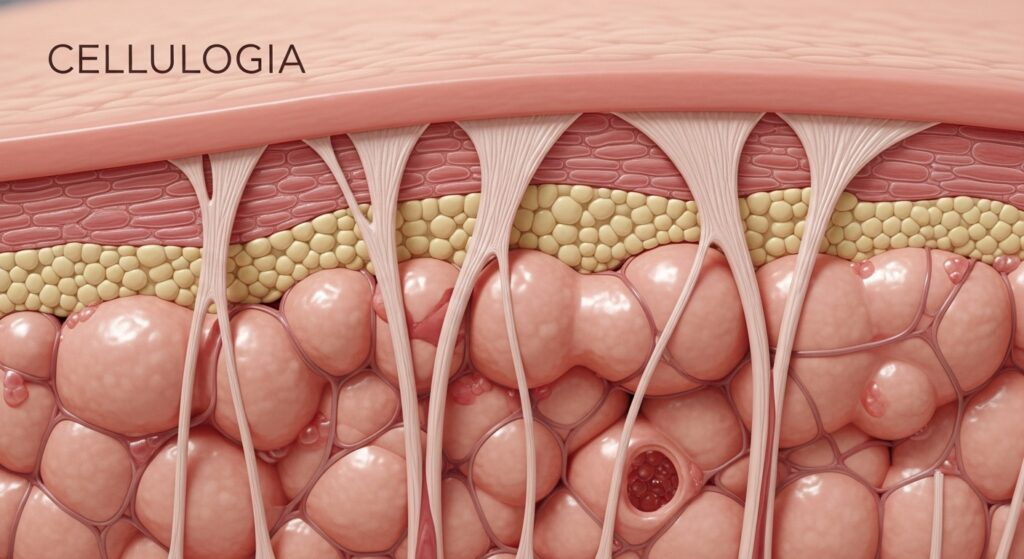Welcome to the world of Cellulogia, where we dive deep into the fascinating relationship between skin texture and beauty standards. For decades, society has placed immense value on smooth, flawless skin, often overlooking the natural variations that make us unique. Have you ever felt pressure to conform to these ideals? You’re not alone. As we explore what cellulite really is, how beauty norms have evolved over time, and the role media plays in shaping our perceptions of attractiveness, you’ll discover a new perspective on your own skin.
Join us as we uncover the science behind cellulite and celebrate body positivity movements that challenge traditional views on beauty. It’s time to embrace every dimple and curve as part of what makes you wonderfully human. Get ready for an engaging journey through Cellulogia!
What Is Cellulite
Cellulite is a common skin condition characterized by dimpled or lumpy areas, often found on the thighs, buttocks, and abdomen. It occurs when fat deposits push through connective tissue beneath the skin’s surface.
While many people associate cellulite with excess weight, it can affect individuals of all shapes and sizes. Genetics play a significant role in its formation. Hormonal changes during puberty, pregnancy, or menopause can also contribute to its appearance.
Often dismissed as merely an aesthetic issue, cellulite reflects deeper connections between our bodies and societal expectations of beauty. Despite being so Cellulogia prevalent—affecting up to 90% of women at some point—it still triggers feelings of insecurity for many.
Understanding cellulite transcends mere labels; it invites conversations about body image and self-acceptance in a society that frequently equates smoothness with desirability.
The History of Society’s Beauty Standards
Beauty standards have always been fluid. They shift with time, culture, and societal values. Historical perspectives on beauty reveal a tapestry woven from diverse ideals.
In ancient Greece, symmetry and proportion defined attractiveness. Sculptures celebrated the perfect human form in marble. Meanwhile, during the Renaissance, fuller figures were admired as symbols of wealth and fertility.
The 20th century saw dramatic changes. The flapper era embraced a boyish silhouette while curvier shapes returned in the 1950s with icons like Marilyn Monroe. As decades passed, trends fluctuated between extremes.
Today’s influences are complex and multifaceted. Globalization has introduced various cultural aesthetics into mainstream consciousness, challenging traditional views on beauty across regions.
As we navigate this evolving landscape, it becomes clear that beauty is not static but rather an ever-changing reflection of society’s values and aspirations.
The Impact of Media and Advertising on Perceptions of Skin Texture
Media and advertising play a significant role in shaping our views on skin texture. From glossy magazine spreads to curated Instagram feeds, the portrayal of flawless skin has become ubiquitous.
These platforms often showcase idealized versions of beauty that exclude imperfections like cellulite. This constant stream of perfection can create unrealistic expectations for many individuals.
As people consume this content, they may internalize these narrow definitions of beauty. It fosters feelings of inadequacy and self-doubt when real bodies don’t measure up to what’s seen in advertisements.
Moreover, the relentless pursuit of smooth skin drives consumerism. Many feel pressured to buy products promising miraculous results, reinforcing negative perceptions about their natural bodies.
It’s essential to recognize how these influences impact mental health and body image while encouraging a broader dialogue around acceptance and authenticity.
Body Positivity Movement and Its Influence on the Beauty Industry
The body positivity movement has sparked a significant shift in how we perceive beauty. It champions the idea that all bodies, regardless of shape or size, deserve respect and love.
This mindset is challenging traditional beauty standards. Social media platforms amplify these voices, showcasing diverse representations of skin textures and sizes. Influencers are now celebrated for their authenticity rather than fitting a narrow mold.
Brands have begun to take notice. Many are expanding their product lines to include a broader range of models that reflect real people. This evolution encourages consumers to embrace themselves as they are.
Promoting inclusivity helps dismantle harmful stereotypes surrounding cellulite and other natural skin characteristics. It’s about celebrating individuality while rejecting unattainable ideals often portrayed in advertising campaigns.
Change is happening slowly but surely; the conversation around body image continues to evolve, influencing not just individuals but also the entire beauty industry landscape.
The Science Behind Cellulite
Cellulite is more than just a cosmetic concern; it’s rooted in biology. The condition arises when fat deposits push through the connective tissue beneath the skin. This results in that familiar dimpled appearance.
Several factors contribute to cellulite formation. Genetics play a significant role, influencing how fat is distributed and how elastic your skin remains over time. Hormonal changes also affect skin texture, particularly estrogen levels during different life stages.
Age can’t be ignored either. As we get older, our collagen production decreases, making skin thinner and less resilient. Lifestyle choices like diet and exercise further impact body composition but are not sole determinants of cellulite presence.
Interestingly, even thin individuals can have noticeable cellulite due to these biological factors. Understanding this science helps demystify why many people experience it, regardless of their weight or fitness level.
Embracing Your Natural Skin Texture
Embracing your natural skin texture can be a liberating experience. It invites you to see beauty in the uniqueness of your body, rather than conforming to narrow standards.
Each dimple and curve tells a story. Instead of hiding behind layers of makeup or restrictive clothing, consider celebrating what makes you, you.
When women publicly share their unfiltered selves, it creates Cellulogia ripple effects. Social media platforms are buzzing with authenticity. This shift encourages others to appreciate their own bodies without fear or shame.
Learning to love every aspect of yourself is an empowering journey. It fosters confidence that radiates far beyond appearances.
Be inspired by those who flaunt their flaws proudly. Your skin’s texture is part of your narrative—embrace it fully and joyfully!
Redefining Beauty Beyond Cellulite
Redefining beauty means embracing diversity in skin textures. Cellulite, often stigmatized, is just one facet of our bodies.
We live in an era where imperfections are celebrated. Body positivity encourages us to see beyond traditional ideals of beauty. It invites everyone to appreciate their unique features.
Social media plays a pivotal role here. Influencers and Cellulogia everyday individuals share unfiltered images that challenge the norm. Their confidence inspires others to love themselves as they are.
Beauty isn’t about achieving perfection but finding strength in authenticity. Every dimple and curve tells a story worth sharing.
By shifting perspectives, we can create spaces where all forms of beauty thrive together, free from judgment or shame. Embracing this vision opens doors for deeper connections with ourselves and others around us.
Conclusion
The conversation around Cellulogia invites us to rethink our perceptions of beauty. Society has long dictated stringent standards that often overlook the natural variations in our bodies. With a history steeped in unrealistic ideals, many have fallen prey to media and advertising’s narrow definitions of what is considered attractive.
However, shifts are occurring. The body positivity movement encourages individuals to embrace all forms of their skin texture, including cellulite. This evolution reflects a growing awareness that beauty exists in diversity and authenticity.
Understanding the science behind cellulite can also empower individuals to appreciate their unique features rather than hide them. By recognizing that skin texture Cellulogia is normal and common, we foster an environment where everyone feels accepted for who they are.
As conversations about Cellulogia continue to grow, redefining beauty becomes essential—one that transcends traditional norms and celebrates every body type as beautiful in its own right. Embracing one’s natural skin texture not only promotes self-acceptance but also inspires others to do the same.
Shifting perspectives on beauty can lead us towards a more inclusive society where each individual feels valued for their uniqueness rather than judged by outdated standards. As we navigate this journey together, let’s commit ourselves to fostering acceptance—not just within ourselves but among those around us too.






